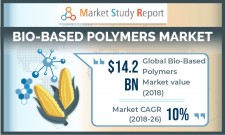Global Bio-Based Polymers Market to Expand With 10% CAGR Through 2026

SELBYVILLE, Del., November 21, 2019 (Newswire.com) - As per the latest research report available at MarketStudyReport.com under the title ‘Bio-based Polymers Market Share, Size, Trends, & Industry Analysis Report, [By Product (PET, PA, PEF, PE, PUR, PBS, PHA, PTT, PBS, Epoxies, PEF, Others), By End-Use (Textile, Automotive, Films & Coatings, Electronics, Industrial), By Regions]: Segment Forecast, 2018 – 2026’, the global bio-based polymers market size is estimated to grow with a CAGR of 10% through the year 2026.
The production of bio-based polymers involves industrial processes wherein raw materials, like plant by-products, livestock waste, or biomass, are polymerized. Though agricultural feedstock is the conventional source for deriving bio-based polymers, recent technology advancements facilitate the production by deriving monomers from bacterial fermentation of proteins, nucleic acids, and polysaccharides.
Request a Sample Copy of This Report @ https://www.marketstudyreport.com/request-a-sample/1868606
The report cites that the bio-based polymers market was worth US $14.2 billion in 2018. Growing awareness regarding sustainability, coupled with rising concerns for the environment are propelling adoption of the product. The use of synthetic polymers is giving rise to various problems such as the need for its disposal and recycling. The combustion of these polymers release greenhouse gases (GHG) leading to global warming and ozone depletion, hence harming the environment. All these issues are compelling the government to take strict actions, along with REACH and EPA regulation regarding the use of fossil fuels and petrochemicals, which is fostering the expansion of bio-based polymers market.
Based on product type, the bio-based polymers industry is classified as PEF, PET, PE, PA, PBS, PUR, PTT, PHA, Epoxies, and others. While as per application spectrum, the market is fragmented as automotive, electronics, textile, films & coatings, industrial, and others.
Considering the regional landscape, the global bio-based polymers market is studies for five main regions; Germany, UK, Belgium, and France fall under Europe; North America comprise of Canada and US; Middle East & Africa is split into UAE, Nigeria, and Saudi Arabia; Mexico, Argentina, and Brazil form Latin America; and India, China, and Japan constitute Asia Pacific.
The key players operating in bio-based polymers market are Lubrizol, Cargill, Bayer Material Science, BASF SE, Dow Chemical, BioAmber, and Bio Based Technologies.
Request Discount on This Report @ https://www.marketstudyreport.com/check-for-discount/1868606/
Report Scope: The Report has segmented the global bio-based polymers market on the basis of Product, End-use and Region:
Bio-based Polymers by Product Outlook (Volume, Kilo Tons; Revenue, USD Million, 2015 - 2026)
· PET
· PA
· PEF
· PE
· PUR
· PBS
· PHA
· PTT
· PBS
· Epoxies
· PEF
· Others
Bio-based Polymers by End-Use Outlook (Volume, Kilo Tons; Revenue, USD Million, 2015 - 2026)
· Textile
· Automotive
· Films & Coatings
· Electronics
· Industrial
· Others
Bio-based Polymers by Region (Volume, Kilo Tons; Revenue, USD Million, 2015 - 2026)
North America
o U.S.
o Canada
Europe
o Germany
o UK
o France
o Belgium
Asia-Pacific
o China
o India
o Japan
Latin America
o Brazil
o Mexico
o Argentina
Middle East and Africa
o Saudi Arabia
o UAE
o Nigeria
Question & Answer: Bio-based Polymers Market
Question 1: Why is the bio-based polymers market witnessing constant growth?
Answer: Growing awareness regarding sustainability, coupled with rising concerns for the environment are propelling the adoption of bio-based polymers. The use of synthetic polymers is giving rise to various problems such as the need for its disposal and recycling. The combustion of these polymers releases greenhouse gases (GHG) leading to global warming and ozone depletion, hence harming the environment. All these issues are compelling the government to take strict actions, along with REACH and EPA regulation regarding the use of fossil fuels and petrochemicals, which is fostering the expansion of bio-based polymers market.
Question 2: What segmentations will impact bio-based polymers market trends?
Answer: Based on product type, bio-based polymers industry is classified as PEF, PET, PE, PA, PBS, PUR, PTT, PHA, Epoxies, and others. While as per the application spectrum, the market is fragmented as automotive, electronics, textile, films & coatings, industrial, and others.
Question 3: How will the bio-based polymers market expand in the forthcoming years?
Answer: The global bio-based polymers market was worth US $14.2 billion in 2018 and is estimated to grow with a CAGR of 10% through the year 2026.
Question 4: Which companies defined the competitive landscape of the bio-based polymers market?
Answer: The key players operating in the bio-based polymers market are Lubrizol, Cargill, Bayer Material Science, BASF SE, Dow Chemical, BioAmber, and Bio Based Technologies.
Related Report:
Synthetic & Bio-based Aniline Market Forecast 2025
Synthetic & Bio-based Aniline Market size will surpass USD 19 billion by 2024
High growth in the Asia Pacific packaging industry will augment the synthetic & bio-based aniline demand throughout the forecast years as the product is a precursor to MDI, which in turn is used in manufacturing polyurethane foams. Polyurethane is extensively used to manufacture rigid as well as flexible plastic packaging materials and their rising demand for interstate to transcontinental transportation of substances boosted by the growing logistics industry will supplement the synthetic & bio-based aniline market up to 2024. The global plastic packaging market was valued at around USD 285 billion in 2016 and is set to exceed 400 billion in 2024.
Source: Market Study Report LLC